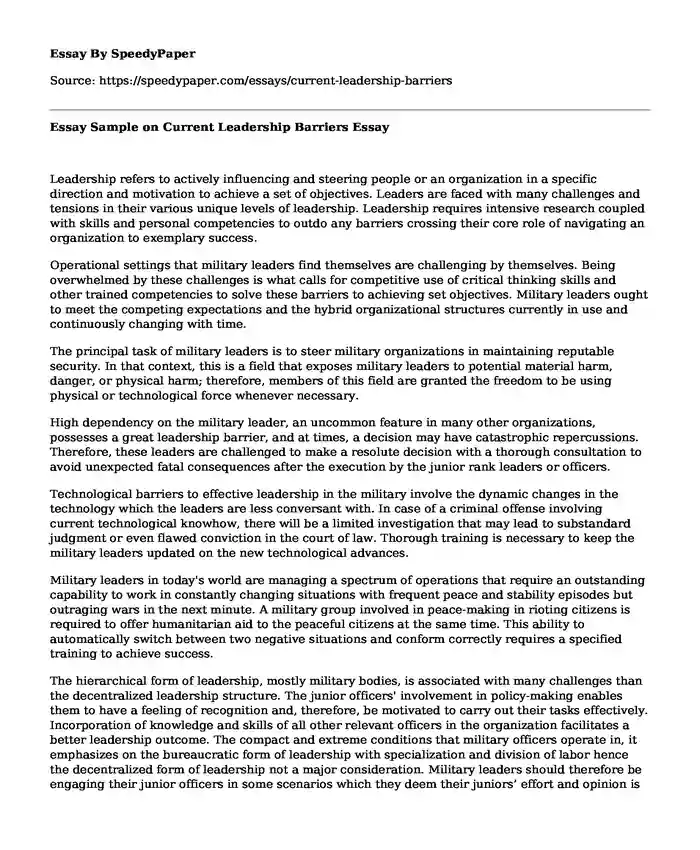
| Type of paper: | Essay |
| Categories: | Leadership analysis |
| Pages: | 3 |
| Wordcount: | 631 words |
Leadership refers to actively influencing and steering people or an organization in a specific direction and motivation to achieve a set of objectives. Leaders are faced with many challenges and tensions in their various unique levels of leadership. Leadership requires intensive research coupled with skills and personal competencies to outdo any barriers crossing their core role of navigating an organization to exemplary success.
Operational settings that military leaders find themselves are challenging by themselves. Being overwhelmed by these challenges is what calls for competitive use of critical thinking skills and other trained competencies to solve these barriers to achieving set objectives. Military leaders ought to meet the competing expectations and the hybrid organizational structures currently in use and continuously changing with time.
The principal task of military leaders is to steer military organizations in maintaining reputable security. In that context, this is a field that exposes military leaders to potential material harm, danger, or physical harm; therefore, members of this field are granted the freedom to be using physical or technological force whenever necessary.
High dependency on the military leader, an uncommon feature in many other organizations, possesses a great leadership barrier, and at times, a decision may have catastrophic repercussions. Therefore, these leaders are challenged to make a resolute decision with a thorough consultation to avoid unexpected fatal consequences after the execution by the junior rank leaders or officers.
Technological barriers to effective leadership in the military involve the dynamic changes in the technology which the leaders are less conversant with. In case of a criminal offense involving current technological knowhow, there will be a limited investigation that may lead to substandard judgment or even flawed conviction in the court of law. Thorough training is necessary to keep the military leaders updated on the new technological advances.
Military leaders in today's world are managing a spectrum of operations that require an outstanding capability to work in constantly changing situations with frequent peace and stability episodes but outraging wars in the next minute. A military group involved in peace-making in rioting citizens is required to offer humanitarian aid to the peaceful citizens at the same time. This ability to automatically switch between two negative situations and conform correctly requires a specified training to achieve success.
The hierarchical form of leadership, mostly military bodies, is associated with many challenges than the decentralized leadership structure. The junior officers' involvement in policy-making enables them to have a feeling of recognition and, therefore, be motivated to carry out their tasks effectively. Incorporation of knowledge and skills of all other relevant officers in the organization facilitates a better leadership outcome. The compact and extreme conditions that military officers operate in, it emphasizes on the bureaucratic form of leadership with specialization and division of labor hence the decentralized form of leadership not a major consideration. Military leaders should therefore be engaging their junior officers in some scenarios which they deem their juniors’ effort and opinion is required.
In conclusion, military leaders are faced with inevitable challenges due to their nature of the profession. Therefore, proper training, critical thinking, timely response to issues, among others, are a prerequisite to effective and productive leadership. Navigation through various challenges will call for personal competencies and appropriate leadership training specific to the leadership field.
References
Novo, B., Landis, E., & Haley, L. (2017). Leadership and its role in the success of project management. Journal of Leadership, Accountability, and Ethics, 14(1). https://www.articlegateway.com/index.php/JLAE/article/view/1615.
Torres, A. (2017). Leadership & Management Styles. Leadership & Management Styles pp. 2-6 Arturo Torres, University of Nevada Las Vegas What is life like after retirement? Pp. 7-9 Christine Kerlin, AACRAO What do you want to be when you grow up? Pp. 10-14, 2. https://www.pacrao.org/docs/PACRAO-Review-October-2017.pdf#page=2.
Cite this page
Essay Sample on Current Leadership Barriers. (2023, Dec 16). Retrieved from https://speedypaper.com/essays/current-leadership-barriers
Request Removal
If you are the original author of this essay and no longer wish to have it published on the SpeedyPaper website, please click below to request its removal:
- Essay Example on Ethical Leadership and Decision-Making
- Essay Sample on Restructuring of a Leadership Team
- Essay Example - GlaxoSmithKline's Financial Analysis
- Work Rules! Insights From Google That Will Transform How You Live and Lead. Essay Example
- Paper Example. Great Leaders No One Has Heard of
- Essay Sample. Purpose Driven Life by Rick Warren
- Free Essay on Influence of Politics and Power in Delta Dental
Popular categories




